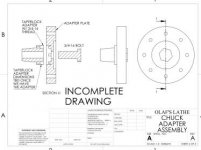I'm rebuilding my old wood lathe. It was made by Cant Brothers around 1880 as a standard post & beam lathe.
I've now pushed it to beyond its boundaries, making bowls 30" + in diameter. All are from one piece of wood. Most are pretty unbalanced.

All that has created a fair bit of rocking in the headstock at times.
Hence the new design of steel 2x4's, massive pillow blocks and then filling it all with concrete.
(ok - maybe I should be sane and stick with smaller stuff....but what fun is that?)
As above, I always start with a large faceplate. When the piece is more balanced (and much lighter) I reverse it and use my Oneway Stronghold chuck
A machinist is currently creating the spindle, an adapter for the existing chuck and several faceplates.
The spindle face will be 8" OD. Then faceplates will bolt to it.

My concern is the chuck adapter on page 2 - for my Stronghold.
The adapter will (likely) be a faceplate, with a taper cone for the Stronghold.

1 - My preferred solution would be to take a large 8" dia piece and just turn it down to the cone. But I;ve been told that material cost and time outweigh the benefits.
2 - Hence the modified idea of using a standard Oneway adapter and a large bolt from the back.
I'm just a bit concerned about the strength of this, if the piece is still off-balance.
I'd be grateful for any ideas or suggestions.
Thanks
I've now pushed it to beyond its boundaries, making bowls 30" + in diameter. All are from one piece of wood. Most are pretty unbalanced.

All that has created a fair bit of rocking in the headstock at times.
Hence the new design of steel 2x4's, massive pillow blocks and then filling it all with concrete.
(ok - maybe I should be sane and stick with smaller stuff....but what fun is that?)
As above, I always start with a large faceplate. When the piece is more balanced (and much lighter) I reverse it and use my Oneway Stronghold chuck
A machinist is currently creating the spindle, an adapter for the existing chuck and several faceplates.
The spindle face will be 8" OD. Then faceplates will bolt to it.

My concern is the chuck adapter on page 2 - for my Stronghold.
The adapter will (likely) be a faceplate, with a taper cone for the Stronghold.

1 - My preferred solution would be to take a large 8" dia piece and just turn it down to the cone. But I;ve been told that material cost and time outweigh the benefits.
2 - Hence the modified idea of using a standard Oneway adapter and a large bolt from the back.
I'm just a bit concerned about the strength of this, if the piece is still off-balance.
I'd be grateful for any ideas or suggestions.
Thanks



